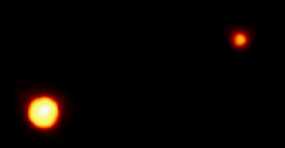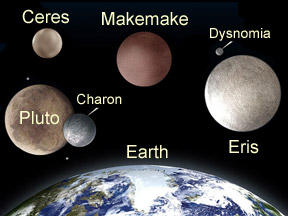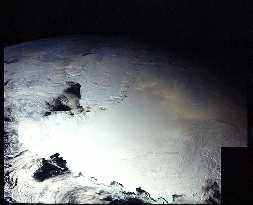This picture shows Pluto (left) and its big moon Charon (right). Notice how big Charon is compared to Pluto. Notice how close Charon is to Pluto. This picture was taken by the Hubble Space Telescope in 1994.
Click on image for full size
Image courtesy Dr. R. Albrecht (ESA/ESO Space Telescope European Coordinating Facility) and NASA.
The Moons of Pluto
Pluto has
moons. One of the moons is very large. The large moon is named Charon. The other
two moons are fairly small. They don't really have names yet. For now they are
called S/2005 P1 and S/2005 P2.
Charon is nearly as big as Pluto. Some astronomers call Pluto and Charon a
double planet. James Christy discovered Charon in 1978.
S/2005 P1 and S/2005 P2 were discovered in 2005. A team of astronomers led
by Alan Stern and Harold Weaver found the moons. The team was looking for
new moons of Pluto using the Hubble Space
Telescope. They were getting ready
for the New
Horizons space mission to Pluto. S/2005 P1 is about 150 km (93
miles) across. S/2005 P2 is even smaller, about 100 km (62 miles) across. S/2005
P1 takes 38 days to go around Pluto. S/2005 P2 orbits Pluto every 25 days.
S/2005 P1 and S/2005 P2 will get "real" names after astronomers observe them
a few more times. They want to make sure they are moons of Pluto before they
give them permanent names.
We don't know whether Pluto has rings or not. Nobody has seen any rings around
Pluto so far.
You might also be interested in:

Pluto is a frigid ball of ice and rock that orbits far from the Sun on the frozen fringes of our Solar System. Considered a planet, though a rather odd one, from its discovery in 1930 until 2006, it was
...more
Charon is a moon of Pluto. Pluto has // Call the moon count function defined in the document head print_moon_count('pluto'); moons. Charon is much larger than Pluto's other moons. James Christy discovered
...more
Of all the planets and moons in the solar system, Pluto and Charon are the two which resemble each other the most closely. They are almost the same size, and they are very close together. They are so
...more
The Hubble Space Telescope (HST) was one of the most important exploration tools of the past two decades, and will continue to serve as a great resource well into the new millennium. The HST found numerous
...more
Astronomers will soon start a search for more moons of Pluto. Pluto has only one known moon, Charon, but astronomers think there might be other moons orbiting Pluto that haven't yet been discovered. Because
...more
Makemake is a dwarf planet in our Solar System. Makemake was discovered in March 2005 by a team of astronomers led by Mike Brown. Makemake officially became a dwarf planet in July 2008. There were three
...more
Pluto is so far away, and has never been explored. Questions to answer about Pluto include the following: What are the geologic features of the surface. (pictures of the surface) If there are bare spots,
...more












